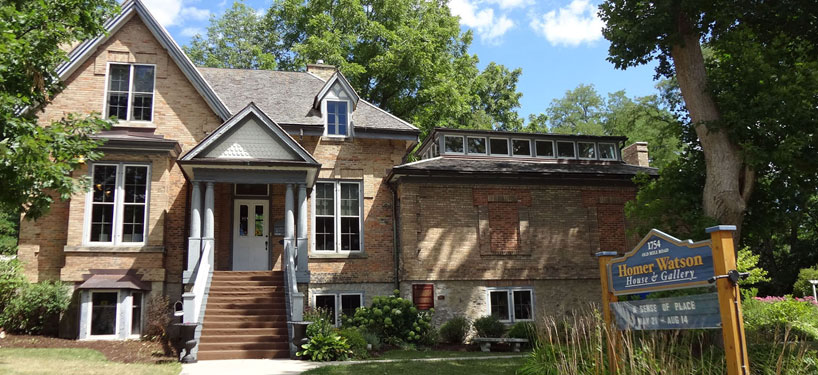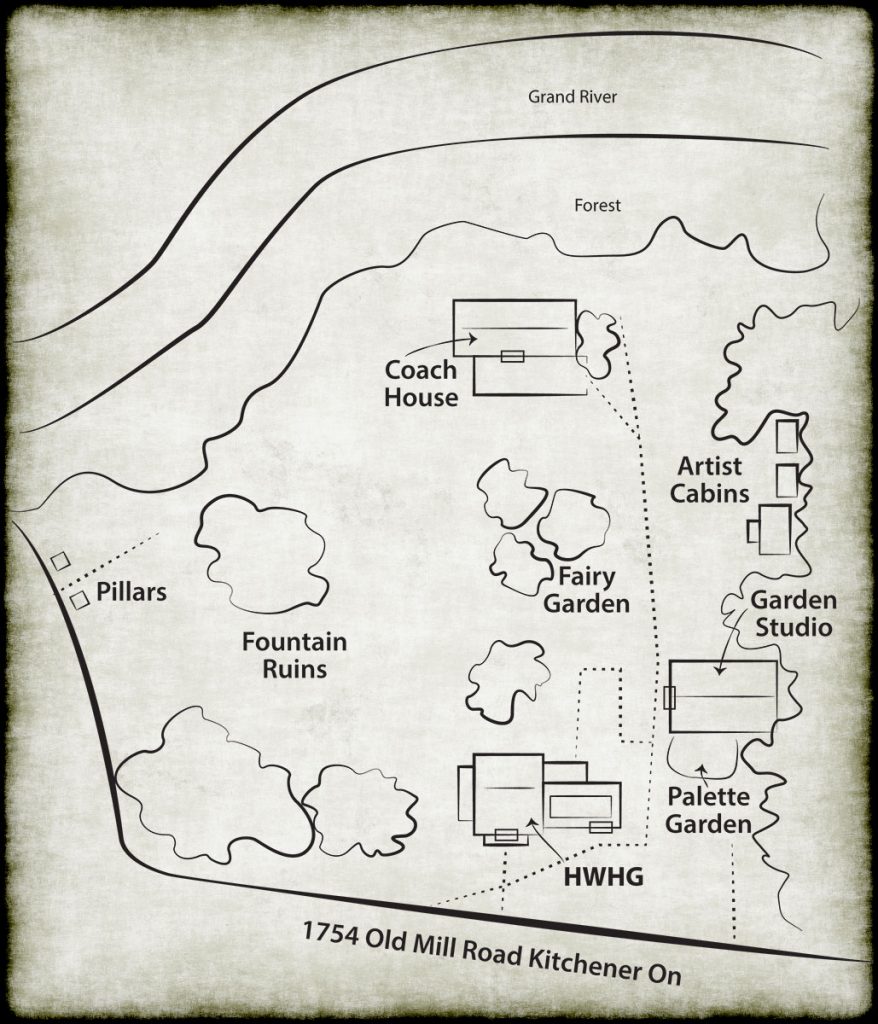Homer Watson Property Tour
The Land at 1754 Old Mill Road
The earliest documented evidence of human settlement in the area goes back to 1500s when at least 2 indigenous groups existed in the Kitchener area, although it is believed that the area was used much earlier. These groups are believed to be the ancestors of the Neutral Nation.
In 1784, an area 6 miles deep on either side of the Grand River was promised to the Six Nations by the British government to provide a new territory for the indigenous peoples who supported them during the American revolution. This was known as the Haldimand Treaty. The Neutral Nations who previously inhabited the area had been largely decimated by illnesses brought over by European settlers. The land was put in the guardianship of “Indian agents” and was leased, sold and reduced over a period of several years. The land was subsequently settled by early Mennonite pioneers.
In 1834, Adam Ferrie Jr. came to this section of the Grand River in search of a location to construct a mill. He found it at the confluence of Schneider’s Creek and the Grand River. The area reminded Ferrie of the River Doon, near Ayrshire, Scotland.
Ferrie came from a very industrious and wealthy family. He bought 300 acres of land and cleared 100 to construct what must have seemed like an empire to the earlier settlers: a stone mill for flour, barley and oatmeal, a distillery, a store, a cooperage (a factory producing casks and barrels) and several homes. The Ferrie companies became a major source of employment and prosperity for the growing community of Doon.
By 1852 the Ferrie enterprises included the grist mill (for grinding grain into flour), a saw mill, tailor shop, blacksmith, shoemaker, wagonmaker, cooperage, tavern, farm, distillery, the Doon Inn, two stores, eleven houses for its workers and twenty lots that were sold to residents. The population of the entire community according to the 1851 census was 452. Robert Ferrie also established a Post office and served as the Postmaster. By 1855, when Watson was born, Lower Doon was still essentially a “company town”.
Ferrie House
Historical Background
The house at 1754 Old Mill Road was built by the Ferrie Family, an affluent industrialist family from Scotland. This substantial house, reminiscent of the vernacular Scottish gothic style is very different from the Georgian style favoured by Mennonite settlers of the early 1800s. The house was built c.1850 on land purchased from John Biehn Jr. by Adam Ferrie to build his mill complex. It is likely that the house was built by Adam’s brother, Robert Ferrie.
Since childhood, Homer Watson admired the Ferrie house for its architecture and light. In the autumn of 1881, he moved into the house with his wife Roxanna, renting the upper floor. The previous year Watson had achieved artistic success when the Marquis of Lorne purchased his painting “The Pioneer Mill” as a gift for Queen Victoria, for the sum of $300. In 1882, the Queen requested another of Watson’s works, “The Last Day of the Drought” and the Marquis also arranged to buy “The Torrent”. Watson now had confidence in his artistic career and the financial means necessary to purchase his dream home.
In 1883, Watson secured the Ferrie house and the two and three quarters acres upon which it was situated. The house would remain Watson’s home for the remainder of his life. By 1893, the painter had added a studio, in which, he later painted a frieze displaying the names of the artists he most admired and landscapes inspired by their works. The year 1906 saw more changes to the house, when a gallery, designed with classical “harmonic proportions”, was added to display Watson’s art. The gallery was intended to show Watson’s works to the many patrons who visited his studio. Clerestory windows allowed natural light to enter the gallery while providing as much wall space as possible to hang his paintings.
Watson also added the porch, enlarged the dormer windows and added the basement bay window in what was the family dining room. The house first got electricity in 1915.
Watson continued to work in the house until his death on May 30, 1936. His sister, Phoebe, remained in the house until her death in 1947. The following year the estate was sold to Ross and Bess Hamilton.
In 1948 the Hamiltons established the Doon School of Fine Arts. Instructors at the School included notable artists such as Fred Varley of the Group of Seven.
The Doon School operated under the Hamiltons until 1966. Later owners, Earl Putnam and Tom and Ruthe Cayley continued to operate the property as a place of learning offering classes in visual arts and displaying the works of Homer Watson to the public. In 1981, the City of Kitchener purchased the historic house from Ruthe Cayley to ensure its survival for future generations. The Homer Watson house continues to this day to be a community hub for the celebration and practice of the arts.
The house is designated under the Ontario Heritage Act and features original main gable block built to an L-Plan. In 1953, a large single storey extension that served as a garage, studio space and dining room for the Doon School of Fine Arts was erected. The space was later used as a pottery studio with a deck above. The extension was demolished in 1990.
Coach House
The coach house and stable is the small brick building behind the house with a stone-walled terrace. The original coach entrance on the west side of the building is now converted into a large window and the structure originally had an outdoor fireplace.
The loft above was likely for hay storage and has 3 windows. This level was probably accessed by an outdoor staircase. The Watsons did not have any horses and did not purchase a vehicle until the 1920s, so the coach house was used as a chicken house during their residence on the property.
By 1955, the coach house had been converted into a studio space. It continues to serve this purpose and is now used as a pottery studio for lessons in both hand built and wheel thrown pottery.
Garden Studio
This modern metal-clad prefabricated structure was installed in 1965 as part of the Doon School of Fine Arts. This building once acted as the pottery studio and is now used for all types of artistic learning.
Fountain Ruins
This stone ruin was once a fountain. Constructed of fieldstone, with an engraving on the reverse reading “Homer Watson” and a date.
Stone Pillars
These two stone pillars mark the original Carriage entrance to the Coach House. They also follow the route of Chalmers Street when it previously connected to Mill Park Drive (formerly Beck Street). This section of the road was closed in 1967.
Fairy Garden
This garden features sculptural pieces by local artist Glenn Smith. Smith studied fine arts at the University of Waterloo and later continued his studies through field work in Scotland, New Zealand, England, France and the United States. He was a founding member of the Waterloo Region Arts Hub, Button Factory Arts and has been exhibiting, teaching and promoting the arts in the Waterloo Region for over 20 years. Smith was the artist in residence at Homer Watson House & Gallery from 2000-2002. He has also taught at Conestoga College and the Tom Thompson Arts Festival. For pricing inquiries or commissions, please visit visitor reception in the main building or email info@homerwatson.on.ca.
Artist Cabins
These cabins were built as accommodation for the students of the Doon School of Fine Arts and date from 1949 to 1951. Each cabin would have accommodated up to 2 students. At its peak, there were 15 cabins on the site forming a semi circle around the coach house. In 1983, all but 3 cabins were removed from the site and sold.
Former Bathhouse
During the Doon School of Fine Arts, a bathhouse was erected behind the coach house for use by the students of the Doon School of Fine Arts. The structure no longer remains.
Phoebe’s Palette Garden
Although Homer and his wife Roxanna were not noted gardeners, documentary evidence suggests that there was a vegetable garden and an orchard on the property during their residence. Homer’s sister, Phoebe Watson, moved into the house after the death of Roxanna in 1918. Letters written by Phoebe indicate that she was an avid gardener who expanded the gardens on the site. Very little physical evidence of these gardens remains.
This garden was created by Homer Watson’s sister, Phoebe Watson. The round garden was meant to mimic her brother’s artist palette with a stone border and clusters of colourful perennials to replicate the paint on the palette. The thumb hole of the palette is marked by a decorative arch created by a former HWHG volunteer but was originally marked by a small tree. The garden is surrounded by several species of trees including sugar maples, spruces, ash trees and black walnuts. The garden was once also surrounded by elms as evidenced by the remaining stumps.










